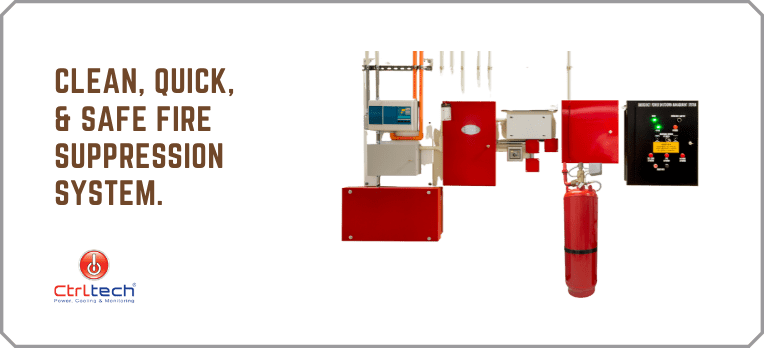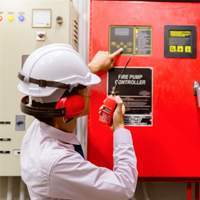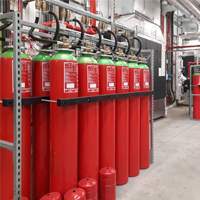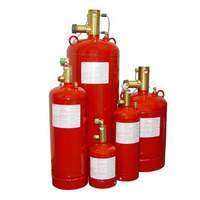
Whether you own a commercial restaurant or a computer server room, there is no doubt that a fire suppression system is critical to safeguarding your business in the event of a fire emergency.
Without a fire suppression system, you run the danger of losing important time, valuable assets, and maybe your entire organisation. The FM-200 fire suppression system is one of the most popular, but what precisely makes the FM-200 system superior to others of its kind?
There are numerous factors to consider when it comes to perforated ..
SKU: CT-FM200-200LBS
MPN: CT-FM200-200LBS
The FM-200 fire suppression system is equipped with highly sensitive detectors capable of detecting even the tiniest fires. Once the FM-200 fire suppression system detects a fire in the room, it can respond quickly, flooding the space with extinguishing chemical and preventing the fire from spreading
When the FM-200 fire suppression system discharges, it does so as a gas rather than a foaming agent, which means that no residue is left behind to damage even the most sensitive equipment! Because there is no cleanup required, you can rapidly resume normal operations with all your systems intact.
When a fire occurs and the FM-200 fire suppression system floods the room with gas to extinguish it, individuals may be exposed to and inhale the gas. The FM-200 agent, on the other hand, is completely safe and will not impair respiration or eyesight.
The FM-200 fire suppression systems are popular because they are a "green" alternative to prior Halon-based systems. The clean FM-200 fire suppression systems are environmentally safe and feature a zero-depletion rate of ozone! You won't have to worry about harming the environment when you use an FM-200 fire suppression system.
The FM-200 is one of the most technologically advanced fire suppression systems available today. The FM-200 fire suppression system is a must-have for any commercial enterprise due to its capacity to safeguard your most important https://www.ctrltechnologies.com/assets swiftly and efficiently while remaining environmentally friendly.
Have you ever considered the ramifications of a fire on your organisation? How will this influence operations?
Each year, fires cost Canadian businesses millions of dollars in damage. And it's not only a matter of safety; organisations are compelled by law to employ specific fire protection measures.
Organizations must manage the risk of fire to ensure the safety of their employees and customers and to minimise property loss. Any organisation must have a plan in place to reduce the likelihood and effect of fires.
The most critical component of any risk management plan is prevention. By proactively limiting risks, organisations save time, effort, and money. Prevention is critical in all aspects of risk management, including fire risk management. Fortunately, there are numerous techniques that a company can implement to assist in preventing fires.
When developing a fire protection plan for your firm, it is critical to evaluate and assess the following threats that could result in a fire:
Visit the Health and Safety Authority's website for additional information on each of these hazards and how to recognise them.
Consider all components of the structure, including the type of roof, the material used to construct the core structure, and the external and interior finishing materials. Buildings should be designed to suit their intended use: take into account their occupants and the activities that occur within. Buildings should ideally be fire resistant or noncombustible.
Fire Resistant: possesses the highest fire resistance rating; typically constructed of reinforced concrete or shielded steel.
Noncombustible: built mostly of noncombustible materials. Unprotected steel and hollow concrete blocks are two examples.
Building codes are frequently updated. Risk managers should monitor for modifications and guarantee continuous compliance on a frequent basis.
Over time, buildings and equipment deteriorate, and fire-resistant materials might become less effective. When this occurs, fire-related risk management ceases to function optimally. Annual inspections by qualified specialists such as contractors, electricians, or licenced inspectors should determine whether any components require repair or replacement. This should be done considerably more often for high-risk equipment.
Effective prevention requires the participation of all individuals. If a single employee produces or fails to disclose a fire hazard, all other preventative measures may be rendered worthless. Organizations may ensure that adequate fire prevention practises are followed at all times by increasing awareness and training staff. This significantly reduces the danger of fire-related events.
While all employees should contribute to fire prevention, delegating duty to a small group increases the likelihood of compliance. These personnel should be knowledgeable of all preventative measures and the duties or individuals for which they are responsible in the event of a fire. Additionally, safety officers can serve as a liaison between frontline staff and risk management.
Employees must be able to report a suspected fire threat immediately and easily. If the procedure is complex, people may lack motivation or be unable to motivate themselves if they are preoccupied with other duties. To effectively avoid fires, dangers such as electrical problems, spills, or blockages must be eliminated immediately upon discovery.
If a fire occurs or is on the verge of occurring, management must be notified. By determining the core cause of previous fires, managers can take preventative measures to avoid a recurrence.
For instance:
Exercise caution when handling explosive materials and ensure that only trained personnel are present in the area where they are being used. Avoid overloading outlets.
When not in use or at the end of the day, unplug appliances. Do not bend or crush cords.
Provide sufficient room for electronics and other heat-generating devices.
Avoid storing flammable materials such as paper or cloth near heat-generating equipment.
When not in use, properly store crates, equipment, and other large things.
Dispose of spills and rubbish promptly and properly
Ascertain that staff smoke in specified areas and have a convenient location for disposing of cigarette butts.
If arson is judged a potential issue, have a lock-up and security measures in place.
Once fire protection techniques have been devised and implemented, they must be codified to guarantee they are carried out on a consistent and timely basis. All employees must be aware, and pertinent information must be made public.



FM-200TM, also known as HFC-227ea, is a Class A, B, and C clean agent fire suppressant that complies with NFPA Standard 2001 for Clean Agent Fire Extinguishing Systems. Clean agents extinguish fires quickly and effectively, are safe to use in occupied environments, and leave no residue.
By breaking the fire triangle, FM-200TM inhibits flames. The fire triangle is composed of three components: heat, oxygen, and a fuel source; when one of these components is removed, the fire is extinguished. FM-200TM eliminates heat and free radicals that obstruct the chemical reaction that extinguishes the fire triangle. Clean agent fire suppression systems, such as those that employ FM-200TM, can attain fire extinguishing concentrations in as little as ten seconds.
Among all gaseous suppression systems, the FM 200 is the most frequently used. It has the following benefits:
FM-200 Gas is non-toxic in nature. It leaves no residue behind upon release and does not cause damage to IT equipment or documents.
It is a gaseous agent with a rapid onset of action.
It is fully eco-friendly. It has no effect on ozone depletion.
It is absolutely safe for human-occupied places. It has no adverse effect on the respiratory system or vision.
It is a non-conductive substance by nature.
FM200 requires three times the storage space required for CO2 gas.
When compared to other environmentally friendly agents, FM-200TM has a slightly higher Global Warming Potential (GWP).
While the FM-200TM does not include Halon, it does employ hydrofluorocarbons (HFC) to extinguish fires, which is less environmentally friendly than other clean agents.
There are primarily two ways to extinguish a fire in a datacenter.
The first approach is an inert gas suppression system that reduces the amount of oxygen in the air to extinguish a fire. It reduces oxygen to 15%, which should make it safer for astronauts.
The second method, dubbed Synthetic Gas Suppression, extinguishes fires by the employment of cooling mechanisms. Synthetic Gas Suppression systems employ a variety of different types of gaseous clean agents, including FM-200, Halon 1301, and CO2. F M 200 is sometimes referred to as HFC-227ea (Chemical name is heptafluropropane). FM200 occupies less space in storage than CO2 agent. Both are non-toxic gaseous compounds. FM-200 installation is straightforward.
CO2 suppression is recommended for unoccupied places, whereas FM 200 is also recommended for occupied spaces. INERGEN may also be used in place of FM-200.
A datacenter's fire suppression system must meet specific requirements. It should be fast, clean, odourless, nontoxic, nonconductive, colourless, and environmentally benign, with minimal storage space requirements in nature. In the event of a fire, the gaseous agent should be released with the shortest feasible delay to reduce damage, which implies it should be rapid. After the gas release and extinguishing operation is complete, there should be no residue left; the area should be completely clean. Additionally, it should not emit an offensive odour. To avoid human dangers, it is preferable that the material is nontoxic in nature. A gaseous agent should not be a good conductor of heat or electricity, as this could result in additional damage. Given the high expense of real estate, particularly in datacenters, the gaseous agent should utilise the least amount of space possible.
